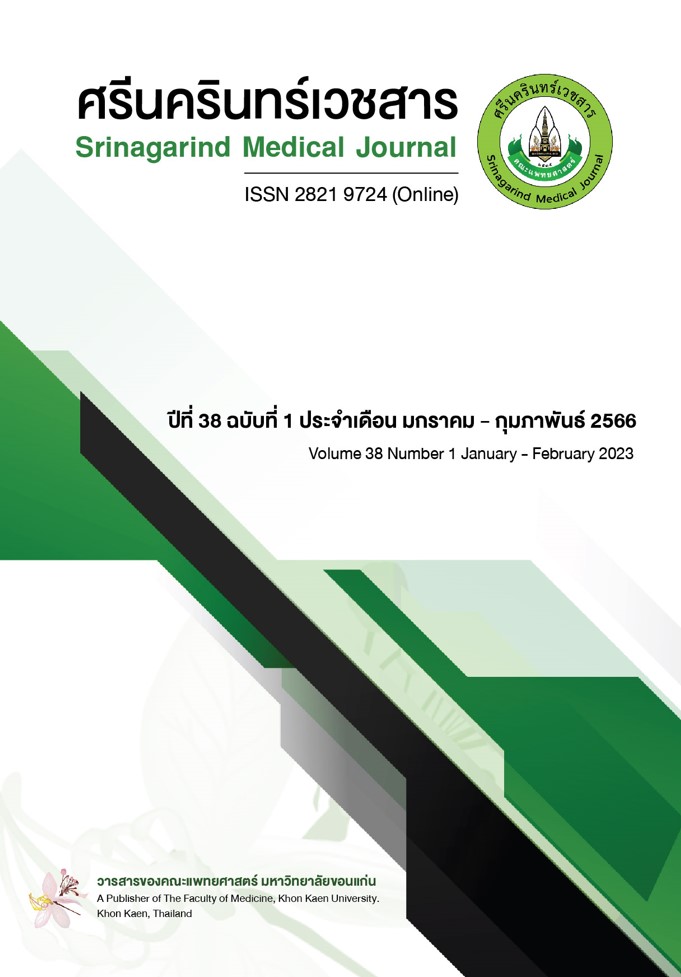Oral Iron Supplementation in Pregnant Women with Heterozygous Hemoglobin E and Homozygous Hemoglobin E in Sakon Nakhon Hospital
Keywords:
iron supplements, pregnant women with hemoglobin EAbstract
Background and Objectives: Pregnant women with heterozygous HbE and homozygous HbE are more likely to develop anemia. This may affect pregnant women and the fetus leading to increased morbidity and mortality rates. Iron supplements have been widely deployed to prevent anemia in pregnant women. Therefore, this study aimed to compare the change of hemoglobin (Hb) after receiving various iron supplements in pregnant women with heterozygous HbE and homozygous HbE.
Methods: This vandomized controlled trial was conducted on 66 pregnant women with thalassemia Hb E from December 2021 to September 2022 in Sakon Nakhon hospital. Data were collected at antenatal care by questionnaires. The demographic data were analyzed using descriptive statistics, Chi-square test and One - way ANOVA.
Results: Amongst 66 pregnant women, they were characterized as 78.8% heterozygous HbE and 21.2% homozygous HbE. The average Hb concentration in the first blood test was 11.8 g/dl (Min = 9.2, Max = 14.2, S.D. = 1.0), and the second blood test was 11.1 g/dl (Min = 9.1, Max = 13.1, S.D. = .9). The average Hb levels in the first and second blood tests of group I, who received 1 tablet of triferdine were 12.0 g/dl and 11.1 g/dl; group II received 1 tablet of triferdine and 1 tablet of ferrous fumarate, which showed 12.1 g/dl and 11.4 g/dl; and group III received 1 tablet of triferdine and 2 tablets of ferrous fumarate, representing 11.3 g/dl and 10.8 g/dl, respectively. The changes in hemoglobin concentration using Chi-square test revealed that 86.4% of group I had statistically significant increased Hb level while 13.6% were decreased (p=0.01). Interestingly, 27.3% of group III showed an increase in Hb level with a decrease at 73.7% (p=0.02).
Conclusion: Iron deficiency should be screened for pregnant women with Hb E thalassemia in order to provide appropriate treatment to rule out iron deficiency in pregnant women with Hb E thalassemia. Thus affecting pregnancy outcomes in particular intrauterine growth retardation (IUGR) and preterm labor. Therefore, appropriate detection of iron deficiency should be undertaken, to treat and prevent iron deficiency in the first and third trimesters (at 12 weeks and 32 weeks of gestation) in pregnant women with Hb E thalassemia with anemia (Hb < 11 g/dl)
References
Massarat P. Iron Homeostasis: Balancing the Acts [Internet]. [Cited Dec 29, 2022]. Available from: https://www.si.mahidol.ac.th/department/Biochemistry/home/articles/iron_homeostasis.htm
Berwal V, Kyal A, Dessa D, Bhowmik J, Mondal P, Mukhopadhyay P. Pregnancy with thalassemia: challenges and outcomes. Int J Reprod Contracept Obster Gynecol 2018;7(4):1613-16.
Smith C, Teng F, Branch E, Chu S, Joseph KS. Maternal and perinatal morbidity and mortality associated with anemia in pregnancy. Obstet Gynecol 2019;134(6):1234-44.
Pooluea C. The prevalence and associated factors of anemia in pregnancy in: Phra Nakhon Si Ayutthaya Hospital, Phra Nakhon Si Ayutthaya Province. JPMAT 2016;6(1):15-26.
Sukkai C, Khiewyoo J. Factors related to anemia among pregnant women in Khaopanom district, Krabi Province. Srinagarind Med J 2016;27(2):133-8.
Wuttichareanwong P. Anemia in pregnant woman at Nongwuaso Hospital Nongwuaso District Udonthani Province. Udhhosmj 2020;28(1):43-51.
Ministry of Public Health. Recommendations for controlling and preventing anemia from the disciplinary system. Nonthaburi: Bureau of Nutrition, Department of Health, Ministry of Public Health; 2013.
Ministry of Public Health. HDC-Dashboard [Internet]. [Cited 2020 dec 10]. Available from: https://snk.hdc.moph.go.th/hdc/main/index_pk.php
Sukrat B, Suwathanapisate P, Siritawee S, Poungthong T, Phupongpankul K. The prevalence of iron deficiency anemia in pregnant women in Nakhonsawan, Thailand. J Med Assoc Thai 2010;93(7):765-70.
Zimmermann MB, Fucharoen S, Winichagoon P, Sirankapracja P, Zeder C, Gowachirapant S, et al. Iron metabolism in heterozygotes for hemoglobin E (HbE), alpha-thalassemia 1, or beta-thalassemia and in compound heterozygotes for HbE/beta -thalassemia1–3. Am J Clin Nutr 2008;88:1026-31.
Kanyakul T, Pakketnung S, Domethong U. Determining Sample Size for Randomized Controlled Trial: RCT) [Internet]. [Cited Jan 13, 2021] Available from: http://sc2.kku.ac.th/stat/statweb/images/Eventpic/60/Seminar/02_6_.pdf
Adaji JA, Isah AY, Agida ET, Otu T, Abdullahi HI. Daily versus twice daily dose of ferrous sulphate supplementation in pregnant women: A randomized clinical trial. Niger J Clin Pract 2019;22(8):1132-9.
Fucharoen S, Weatherall DJ. The hemoglobin E thalassemias. Cold Spring Harb Perspect Med 2012;2(8):1–15.
Fucharoen S, Winichagoon P. Hemoglobinopathies in Southeast Asia. Hemoglobin 1987;11(1):65–88
Cunningham F, Leveno K, Bloom S, Spong Y, Dashe J, Hoffman B, et al. Williams obstetrics (24th ed.). New York: McGraw-Hill Education; 2014.
Tongsong T, Srisupundit K, Luewan S. Outcomes of pregnancies affected by hemoglobin H disease. Int J Gynaecol Obstet 2009;104(3):206–8.
Traisrisilp K, Luewan S, Tongsong T. Pregnancy outcomes in women complicated by thalassemia syndrome at Maharaj Nakorn Chiang Mai Hospital. Arch Gynecol Obstet 2009;279(5):685–9.
Wanapirak C, Muninthorn W, Sanguansermsri T, Dhananjayanonda P, Tongsong T. Prevalence of thalassemia in pregnant women at Maharaj Nakorn Chiang Mai Hospital. J Med Assoc Thai 2004;87(12),1415–8.
Downloads
Published
How to Cite
Issue
Section
License
Copyright (c) 2023 Srinagarind Medical Journal

This work is licensed under a Creative Commons Attribution-NonCommercial-NoDerivatives 4.0 International License.



